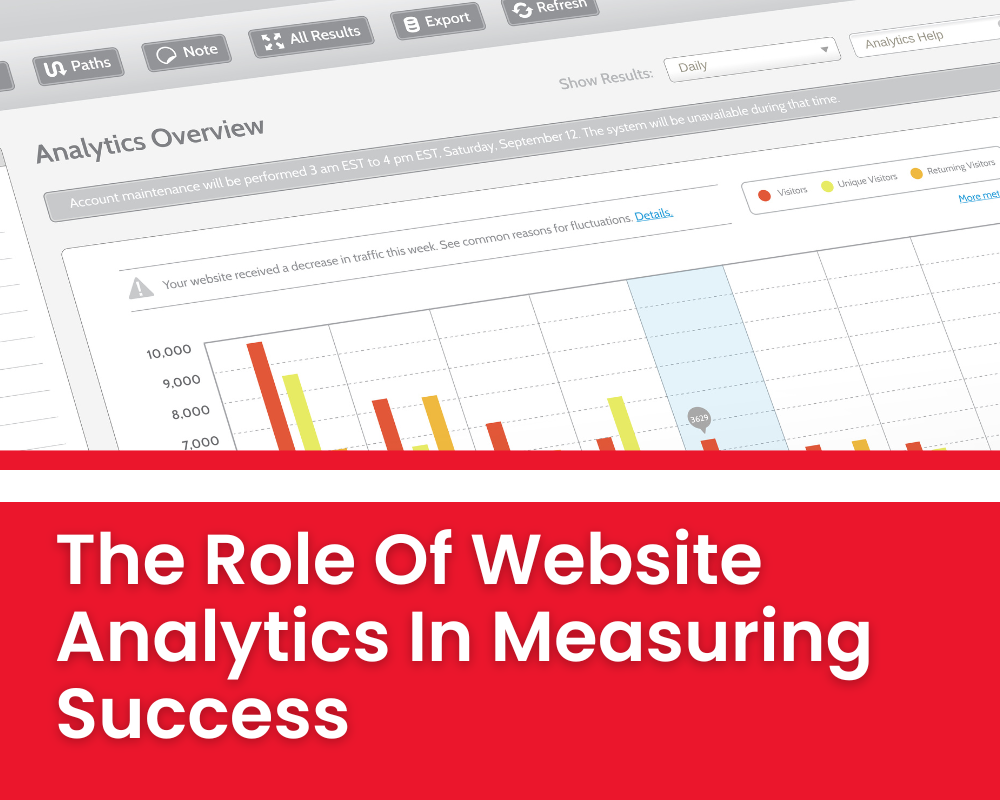How and Why You Should Incorporate AI into Web Development
AI and web development are two of the most popular and talked-about topics in the tech world today. And for […]
Dec 8, 2022
May 3, 2023

Website analytics provide a comprehensive overview of an organization’s online presence and performance. By tracking key metrics such as website visitors, page views, bounce rates, and other user behaviour data, organizations gain invaluable insights into the effectiveness of their marketing campaigns, web design strategies and overall success. This article will explore the role of website analytics in measuring success from both qualitative and quantitative perspectives.
Website analytics is the process of measuring, collecting, analyzing and reporting on web data for purposes of understanding and optimizing website usage. It is used to measure a website’s success in terms of goals such as increased traffic or sales conversions.
Website analytics use various metrics to provide insights into user behavior on websites, including page visits, time spent on pages, bounce rates, clicks per page and more. By tracking these metrics over time, businesses can gain valuable insight into which parts of their sites are performing well and what areas need improvement.

Analytics goals vary from business to business depending on the purpose of the site and the desired outcome. For example, an e-commerce site may focus primarily on increasing conversion rate while a news outlet may prioritize reducing bounce rate by creating content that encourages users to stay longer. Ultimately, it’s important for any business with a presence online to understand how its visitors interact with their website so they can improve performance and create better experiences for their customers.
Website analytics provide a valuable perspective on website performance, allowing businesses to identify areas of optimization and improvement. By analyzing user behaviors such as page visits, clicks, time spent on the site, and more, website owners can gain insight into customer engagement levels and determine how to improve the overall user experience. Additionally, data visualization tools help make complex datasets easier for business owners to interpret at-a-glance.
A key benefit of website analytics is that decisions about changes or improvements can be based on facts rather than assumptions. With an in-depth understanding of customers’ behavior patterns, companies are better equipped to develop strategies that align with their objectives. This could include anything from improving content delivery times by optimizing images or videos to using search engine optimization techniques to increase online visibility and drive traffic towards desired pages.
Website analytics are important when it comes to measuring the success of a website. They provide insight into how visitors interact with a website and can be used to identify areas of improvement or optimization. There are numerous metrics that can be measured using website analytics, including traffic sources, conversion rates, bounce rates, and time spent on pages.

Traffic sources refer to where visitors come from; they could be organic searches, referrals from other websites, direct visits, or social media platforms. Knowing the source of visitors helps webmasters understand which marketing channels are most effective in driving traffic to their site. Conversion rates measure the percentage of visitors who take action after visiting a website—this could include making purchases, signing up for newsletters or subscribing for services.
Bounce rate measures the number of people who leave a page without viewing any other content on the site; high bounce rates indicate that there is something wrong with the page being viewed and may require further investigation.
Finally, time spent on pages gives an indication as to how much engagement each page receives and if users find value in what’s been presented on them. By tracking these metrics over time, it is possible to gain valuable insights into user behavior and patterns which can then inform decisions about future strategies for improving performance.
The use of website analytics is integral in measuring the success of an online business or organization. When setting goals and objectives for a website, it is important to understand what metrics are available through website analytics tools. This allows data analysis to be tailored to specific tracking metrics related to the particular goals and objectives set for the website.
By utilizing various types of analytics such as page views, unique visitors, time on site, bounce rate, etc., businesses can gain insight into how successful their web presence is in achieving its intended purpose. These insights provide valuable information that can be used to improve strategies going forward by making informed decisions based on accurate measurements and data-driven conclusions. Furthermore, these findings can help determine which existing strategies should be removed or improved upon in order to maximize success rates.
Data analysis is essential when it comes to website analytics and measuring success. Analysis of the relevant data allows for performance metrics to be established, providing insight into user engagement on a website. This can include monitoring traffic trends in order to identify areas where improvement may be needed, or identifying features that are particularly successful with users.
It also provides information about visitors’ locations and their navigational paths within a website, which helps inform decisions regarding content optimization. Furthermore, analyzing data enables an understanding of customer behavior and preferences, helping maximize the value of marketing campaigns by targeting customers more effectively. As such, effective data analysis is necessary to ensure accurate measurement of success as well as informed decision-making processes related to website optimization.
The insights gained through data analytics provide valuable guidance when developing strategies for improving user experience and increasing conversions. Understanding how different elements contribute towards overall goal achievement will help shape future strategy and objectives while at the same time optimizing the existing ones accordingly. Through this process organizations can develop improved tactics for reaching goals more efficiently and achieve better results from their online presence.
Having explored the role of website analytics in measuring success, it is now important to consider how those insights can be used to adjust strategies. The data collected from website analytics should be interpreted in order to gain insights and make predictions about the performance of a business or organization. With this data as a foundation, businesses can use these insights to adjust their strategies accordingly:
By leveraging key findings derived from website analytics, organizations have the ability to create more targeted strategies and fine-tune existing ones in order to achieve desired outcomes. Additionally, understanding customer preferences allows companies the chance to stand out amongst competitors and ultimately increase sales and ROI.
In conclusion, website analytics provides valuable insights that allow organizations to measure success with accuracy and precision. The ability to monitor key performance indicators allows businesses to remain competitive in today’s everchanging digital landscape. With its use comes improved decision making capabilities through increased understanding of customer preferences and behaviors which leads to improved strategy development overall.

AI and web development are two of the most popular and talked-about topics in the tech world today. And for […]
Dec 8, 2022

Mobile app development has undergone a profound evolution, reshaping the way businesses operate and individuals engage with technology. As we […]
Oct 5, 2023

If you’re new to the crypto world, one of the first things you’ll need is a good crypto wallet. A […]
Dec 8, 2022
Join our newsletter and be the first to receive future promo and sale updates from Rooche!